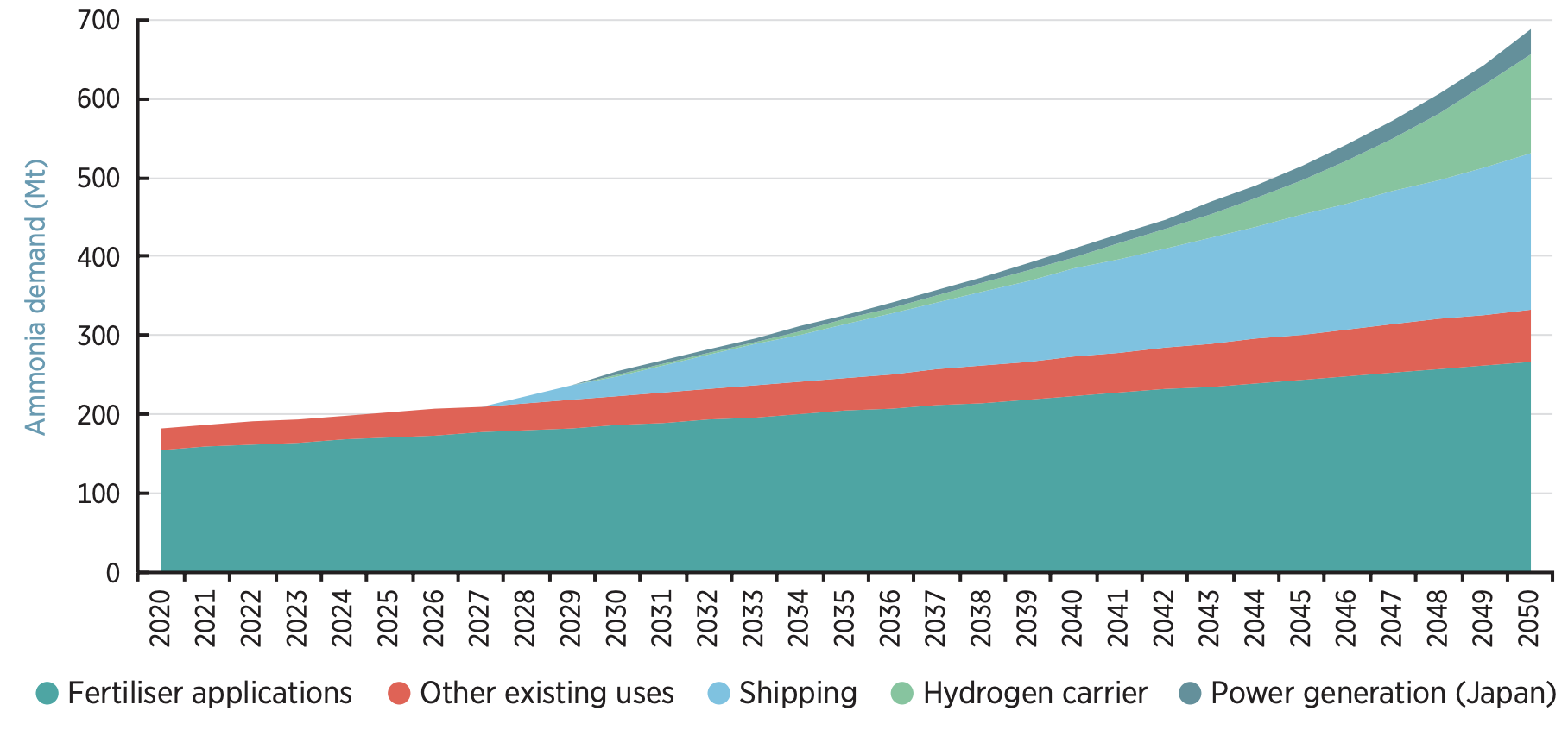
World's first dynamic green PtA plant takes shape.jpg (Source: ABB)
Editor's note: This article has been updated with additional details.
Having too much renewable energy means missed opportunities — to produce, use or store power in parts of the world with abundant solar and wind energy such as California, Denmark and Germany.
However, a group of developers aims to capture and convert excess electricity, putting concerns about overloading power grids to rest.
The concept: store surplus wind and solar energy by funneling it into another medium: ammonia. The conversion allows spare electricity from renewable sources to be ramped up or down based on need.
Skovgaard Energy, Topsoe and Vestas in collaboration with ABB are in the test phase to create a dynamic, first-of-its-kind power-to-ammonia (PtA) demonstration project in Denmark.
Construction of the 10-megawatt (MW) project is underway as the world transitions to lower carbon energy sources. Renewable ammonia, produced with renewable electricity for hydrogen production and nitrogen purification from the air, is expected to play a major role in decarbonizing hard-to-abate industries such as shipping.
“When you have surplus energy in the grid and suddenly you can utilize that electricity to produce something that is renewable, that’s the whole Power-to-X,” Martin Petersen, head of sales for ABB Energy Industries, Denmark, told Hart Energy.
Think of the X as a variable. “The X could be hydrogen as a standalone, ammonia, e-methanol that you use on airplanes, in the shipping industry or other places. The X is the renewable fuel,” he said.
Storing fluctuating energy is a challenge today. Power-to-X offers a solution, he said.
Power-to-X (PtX) projects have been around for decades, drawing electricity from conventional power sources fueled by natural gas. The project in Denmark would similarly put excess renewable electricity to use by producing e-ammonia, a derivative of hydrogen, only when excess renewable energy is available and gearing down when it isn’t—unlike other PtX plants connected directly to the grid.
‘Dynamic’ mode
Located in northwest Denmark, the PtA plant will be run on energy produced by 12 MW wind turbines from Vestas utilizing ammonia process expertise from Topsoe with a 50 MW solar system developed by Skovgaard, a Danish developer that also has wind turbines connected to Denmark’s grid.
“When it makes economic sense, they deliver on the grid and when it doesn’t make sense, they can benefit from producing ammonia,” Petersen said.
Normally, ammonia is produced using a constant flow of electricity from the grid.
With this PtX project, electrolyzers—which split water to make hydrogen via electrolysis for ammonia—will ramp up or down depending on the amount of excess wind and solar energy. The dynamic nature of the project means maximized efficiency and optimal energy use, according to ABB, which is carrying out electrical integration and advanced process control for the project.

Plans are for the facility to start operating in 2024 and produce 5,000 tons of ammonia per year.
The project’s success hinges on each component’s ability to adjust to changes.
“If it can, that is then possible to scale it,” Petersen said.
Pulling it all together from an automation, electrical and instrumentation standpoint will not be an easy feat. Among the tasks ahead: designing quick connections, leveling out noise feedback from the grid and optimizing production as electricity and ammonia prices vary, according to Petersen.
With the design phase complete, work has started on facilities that will house the electrolyzers and the 50 MW of solar is being erected.
ABB is currently focused on the automation aspects of the project.
It helps to be involved in the process early, according to Tom Zøllner, head of ABB Energy Industries for Denmark. “We can see that we are strengthening the entire process and the outcome of it,” he said.
Bottlenecks, however, could come with electrolyzers, which are in high demand. Legislative moves to incentivize demand for lower carbon energy sources or carbon taxes could also be factors.
“If we can see there is a demand on the other end, this will speed up the process,” Zøllner said. If legislators lend further support “it will also ensure that we will scale up. Speed and scaling are so crucial at the moment when we’re talking [about] ammonia and Power-to-X.”
The project has received about $12 million from the Danish government’s Energy Technology Development and Demonstration Program.
“When it comes to the infrastructure in Denmark due to a lot of piping, etc., we are definitely in a sweet spot,” Zøllner said.
Looking ahead
Eyeing potential ammonia demand growth, Zøllner is optimistic about the team’s ability to scale. Transporting surplus energy as ammonia is the way to go, he said.
According to the International Renewable Energy Agency (IRENA), worldwide production of ammonia is expected to grow as demand rises to an anticipated 223 million tonnes (MMtonnes) by 2030 and to 333 MMtonnes by 2050 in a 1.5 C scenario. Growth will be driven mainly by production growth, pushing up the need for ammonia for fertilizer applications—which could rise to 267 MMtonnes in 2050, up from 156 MMtonnes in 2050. IRENA data show ammonia production was 183 MMtonnes in 2020.
“Significant new markets are expected to develop over the coming decades for ammonia as a hydrogen carrier, as a fuel for stationary power and heat, and as a transport fuel, particularly in the maritime industry,” IRENA said in a report. “While current markets contribute most of the growth in demand this decade, energy markets may account for a much faster growth rate after 2030. By 2050, global ammonia demand is estimated to reach 688 Mt in a [1.5 C] scenario, more than three times the demand expected in 2025.”
Renewable ammonia is expected to dominate markets in the long run. Hydropower has historically sourced renewable ammonia; however, fossil fuel derived ammonia dominates today, with less than 0.02 MMtonnes of renewable ammonia produced annually today, according to IRENA. The decarbonization drive is expected to change that, presenting opportunities for green ammonia.
All of the Xs in Power-to-X will be needed for the energy transition.
“This is an industry that is moving quite fast. … The technology is there, the knowledge is there,” Petersen said. “So, it’s more about making sure that we connect the right people.”
Zøllner added, “It’s a lot of collaborations between different types of companies, meaning that there's no big player,” Zøllner added.
First ammonia production is expected by first-quarter 2024.
Recommended Reading
Santos’ Pikka Phase 1 in Alaska to Deliver First Oil by 2026
2024-04-18 - Australia's Santos expects first oil to flow from the 80,000 bbl/d Pikka Phase 1 project in Alaska by 2026, diversifying Santos' portfolio and reducing geographic concentration risk.
Iraq to Seek Bids for Oil, Gas Contracts April 27
2024-04-18 - Iraq will auction 30 new oil and gas projects in two licensing rounds distributed across the country.
Vår Energi Hits Oil with Ringhorne North
2024-04-17 - Vår Energi’s North Sea discovery de-risks drilling prospects in the area and could be tied back to Balder area infrastructure.
Tethys Oil Releases March Production Results
2024-04-17 - Tethys Oil said the official selling price of its Oman Export Blend oil was $78.75/bbl.
Exxon Mobil Guyana Awards Two Contracts for its Whiptail Project
2024-04-16 - Exxon Mobil Guyana awarded Strohm and TechnipFMC with contracts for its Whiptail Project located offshore in Guyana’s Stabroek Block.





